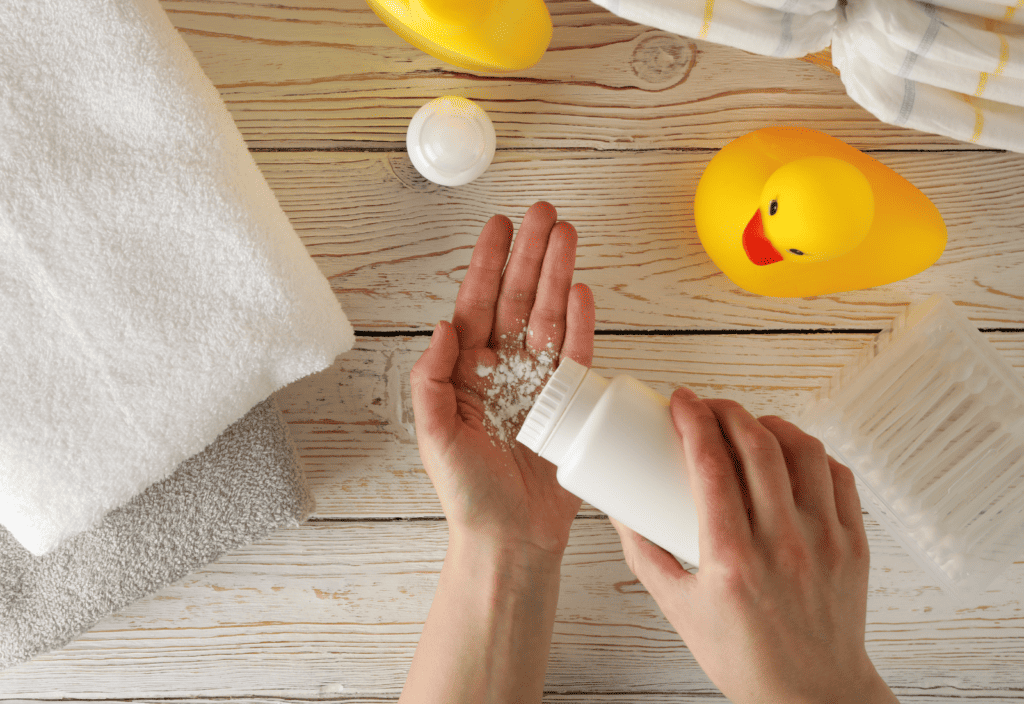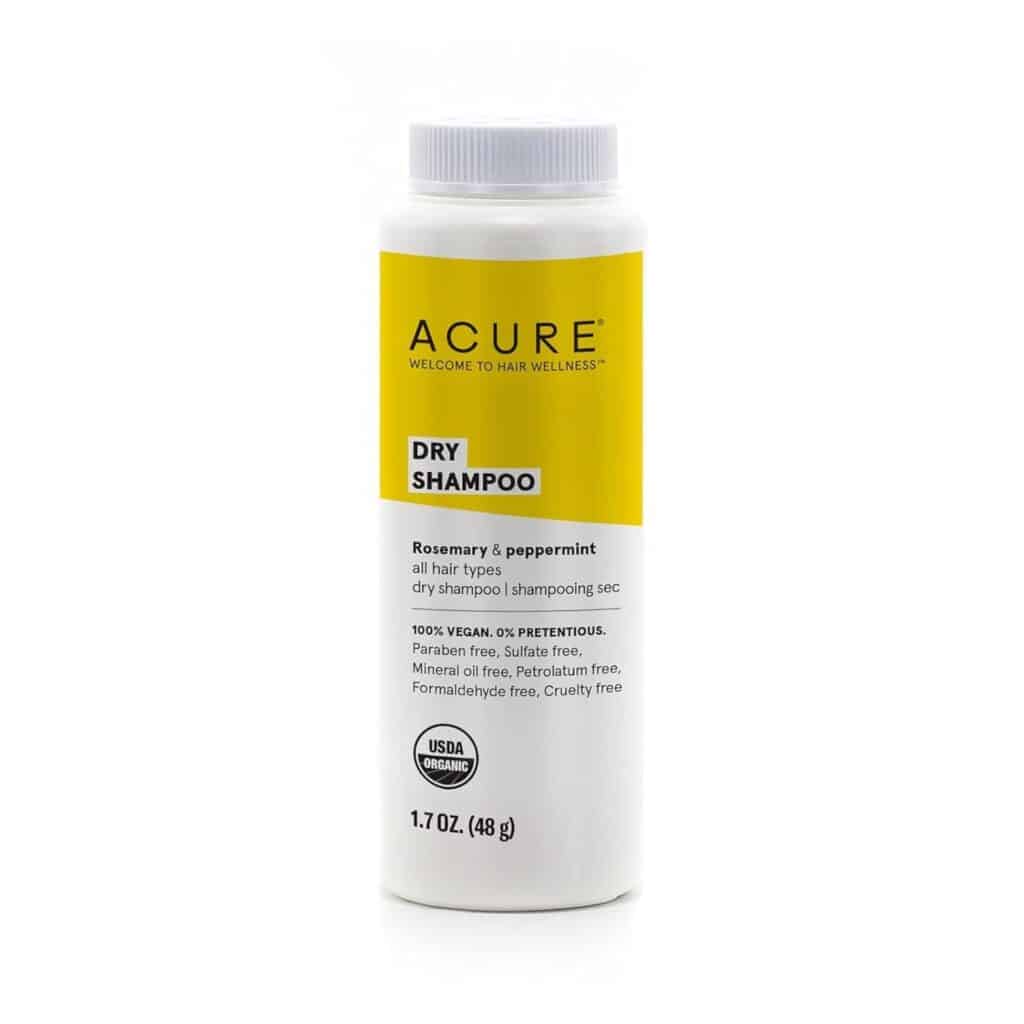Is dry shampoo toxic? Assuming we are talking about the most popular brands in the aerosol cans—yes. but don’t fret, because there are lots of safer options out there. This post will take a look at some of the yuckies in popular dry shampoos and explore some safer, healthier options.

To be fair, lots of things we come in contact each day are “toxic.” My goal, and maybe yours too, is to avoid as many toxins as I can while still leading a fairly normal life. When I started cleaning up my lifestyle, hair products were towards the top of the list.
My thought process is to focus on what goes in the body first, what goes on the body second and your environment third (assuming it’s nothing too crazy or you may want to move this up the list). Our skin is our largest organ, so what goes on our skin is often absorbed all the way into the bloodstream.
Hair is somewhat separate from the skin, of course, but the scalp is just like the rest of our skin, and dry shampoo is usually sprayed on the roots. In addition, anything you put on your hair, you likely inhale then keep inhaling to some degree until it’s been washed out.
2022 Dry Shampoo Recall
You likely heard about the recent dry shampoo recall. Unilever, a global consumer goods company that specializes in beauty and personal care products, recently announced a voluntary recall of 19 popular dry shampoo aerosol products sold in the United States.
The recall was due to concerns about benzene, a chemical known to cause cancer. Exposure can occur through inhalation, ingestion or skin contact. Benzene is linked to cancers including leukemia and blood cancers.
This is the first time that some have worried about their dry shampoo being safe, but should we have worried long before? Probably so, unless you were already using a clean brand. Let’s dive into some of the troublesome common dry shampoo ingredients.
Propellants
Aerosol sprays contain propellants, which propel the contents of the can outward (hints the name). Three common propellants are butane, isobutane and propane, which are derived from petroleum and natural gas and known as LPGs. While these gases are considered generally safe for cosmetic use, they are potentially dangerous if they come in contact with the eyes, throat and lungs.
In rare cases of misuse, butane is even linked to cardiac arrest. These gases are also what make aerosol cans highly flammable and combustible. You have to be careful about where you store and how you dispose of the cans. If they become hot or if the can is penetrated, they can be quite dangerous.
Talc
Talc or talcum powder is another common problematic dry shampoo ingredient that you may want to avoid. It is a drying agent used to absorb oil from hair and has historically been contaminated with asbestos. Until recently it was the main ingredient in baby powders and finishing powder used by many barbers.
If a man in your life sees a barber, be sure to ask if the finishing powder contains talc. When I finally put this together and inquired, thankfully my husband’s barber was using a cornstarch-based product. Cornstarch has largely replaced talc in baby powders and similar products.

This post contains affiliate links. At no additional cost to you, I may earn a small commission from qualifying purchases.
Contaminated talc is linked to various types of cancer. Cosmetic talc is supposed to be safety tested, but many still wish to avoid the risk altogether. While talc is a powder, some dry shampoo sprays contain it as well.
Fragrance
Fragrance showed up in nearly all of the powder and spray shampoos I looked at. Did you know that fragrance is banned in EU cosmetic products? Fragrance is a known allergen and hormone disruptor. Not to mention, it gives lots of people a big ole headache. Many find that artificial fragrances trigger their migraines as well.
Fragrance, often listed as parfum, is probably one of the most commonly used toxins in cosmetics and self-care products. Using synthetic fragrance is much easier and cheaper than sourcing natural scents.
There are other various concerning ingredients that sporadically show up in dry shampoo formulas: benzol alcohol, hydroxycitronellal, cetrimonium chloride to name a few, but none are larger offenders than the propellants, fragrance and talc.
One sure way to avoid questionable ingredients in dry shampoo is to make it yourself from trustworthy ingredients.
DIY Homemade Dry Shampoo
I’ve been making my own dry shampoo for several years now. It’s simple, cheap and, most importantly, you don’t have to worry that you are dousing yourself in toxic ingredients. You can literally eat the main ingredients, which says a lot about the safety. I hope you’ll join me as we open the pantry and whip up this dry shampoo recipe ;).

Natural Dry Shampoo Recipe
Ingredients
Equipment
Method
- Scoop cornstarch into your jar.
- Scoop in your cocoa and/or cinnamon until you get a color close to yours. It doesn't have to be perfect. It is hard to achieve the darkest browns and blacks.
- Put the lid on your jar and shake up your mixture.
- Use a makeup brush to apply the powder to your roots.
- Give it a few minutes to absorb oil then style as normal.
A wide-mouth mason jar works great for this. I have used several types of containers, but this tends to create the less mess in my experience. I have a standard EcoTools make up brush, which you can simply leave sitting in the mason jar. Eco Tools also offers a retractable brush with a lid that may work well especially if you want to be able to put the lid on your shampoo jar and store it between uses.
Clean Store-Bought Dry Shampoo Brands
If you prefer to buy a clean store-bought brand rather than make your own dry shampoo, here are three trustworthy brands that rank well in the Environmental Working Group (EWG) database.
Acure
There are two versions of Acure Dry Shampoo—one for any hair color and one specifically for brunettes (pictured below). Acure is one of my favorite brands in general. I have used their products for years, and they never try to sneak questionable ingredients into their formulas.
Their formula is free of all of the ingredients we discussed above as well as being sulfate, mineral oil and paraben free. This is a powder with a twist cap that can shake directly into your hair then rub in.
Beauty by Earth
Beauty by Earth is another great trustworthy brand. Their dry shampoo is certified organic, sulfate and paraben free. At this time, I only see one option, and it’s for red or dark hair. They have a standard size and travel size available. Their formula uses cornstarch and arrowroot powder to absorb oil.
Earthly
Earthly is an Ohio-based small business and brand that you may want to give a try. Their all-natural dry shampoo uses clay and powdered herbs to soak up excess oil while leaving behind a fresh scent. At this time, it’s only available via their company website. The reviews and price point are pretty great.

All three of these brands are quite affordable and have lots of positive reviews. I checked out several other clean brands that were twice the price with less favorable reviews, so these are the ones that I felt like offered consumers the most value.
So, is dry shampoo toxic? Well, yes, it can be, but thankfully it doesn’t have to be! As always, thanks for stopping by and hanging out for a bit.


This is very helpful information; thank you for making me aware of these harmful toxins.
I’m glad! Thanks so much for taking the time to read the post :).